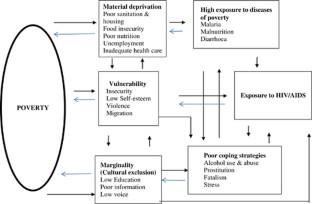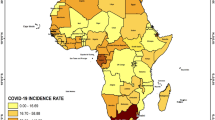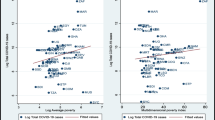Abstract
There is an increasing recognition that poverty in Africa is a critical factor in the transmission of HIV/AIDS. To this end, at a macro level some theorists have described HIV/AIDS as one of the diseases of poverty. ‘Diseases of poverty’ are those that primarily affect the poor, and which worsen the toll of poverty. Many if not most countries severely affected by HIV/AIDS are also in the global south and poverty stricken, but this does not necessarily mean poverty leads to HIV infection. In fact, evidence on the relationship between HIV transmission and poverty remains mixed. While some macro and micro studies find a positive relationship between poverty and HIV, others do not. Although efforts have been made to tackle the issue of poverty as a way of dealing with HIV/AIDS, the role played by poverty in HIV/AIDS remains poorly understood. There are several impediments to understanding the poverty and HIV/AIDS nexus. First, researchers who investigate the poverty and HIV relationship have failed to take into account conceptual and theoretical advances in the literature on poverty. In the process they have failed to specify what aspects of poverty might be related to HIV/AIDS. Second, there is little agreement on how poverty should be measured. Choice of the poverty measure is much more than just a technical detail, and is reflective of social concerns and values inherent in debates over poverty. Third, researchers in this area use different definitions of poverty, but different definitions of poverty lead to different measures of poverty, yielding different groups of people. This article evaluates studies in Africa that look at the role played by poverty in HIV/AIDS transmission at both macro and micro level. It examines the conceptual and methodological obstacles that prevent a clear sociological understanding of the poverty–HIV/AIDS behaviour dynamic. In this article we develop a framework for conceptualizing poverty and its relationship to HIV/AIDS. We look to common and well-formulated ideas in the literature on poverty to develop the framework. We suggest material deprivation (relative and absolute), vulnerability and social exclusion as the core ideas in recent advances in the literature on poverty. We then identify possible social, structural and behavioural pathways between these aspects of poverty and link them to HIV/AIDS.

Similar content being viewed by others
References
Abrahams, N., Jewkes, R., Laubscher, R. and Hoffman, M. (2006) Intimate partner violence: Prevalence and risk factors for men in Cape Town, South Africa. Violence and Victims 21: 247–264.
Agyei-Mensah, S. (2006) Poverty and HIV prevalence in Ghana: A geographical perspective. GeoJournal 66 (4): 311–324.
Alcock, P. (1997) Understanding Poverty. London: Palgrave Macmillan.
Anglewicz, P. (2012) Migration, marital change, and HIV infection in Malawi. Demography 49 (1): 239–265.
Baral, S. et al (2009) HIV prevalence, risks for HIV infection, and human rights among men who have sex with men (MSM) in Malawi, Namibia, and Botswana. PLoS ONE 4 (3): e4997.
Beaulier, S. (2003) Explaining Botswana’s success: The critical role of post-colonial policy. Cato Journal 23 (2): 227–240.
Beckfield, J. (2004) Does income inequality harm health? New cross-national evidence. Journal of Health and Social Behavior 45 (3): 231–248.
Bernstein, H. (1992) Poverty and the poor. In: H. Bernstein, B. Crow and H. Johnson (eds.) Rural Livelihoods. Oxford: Oxford University Press.
Bloom, D., River Path Associates Sevilla, J. (2002) Health, wealth, AIDS and poverty, Manila, Asian Development Bank, http://www.hivpolicy.org/Library/HPP000622.pdf, accessed 12 December 2012.
Bond, P. (1999) Globalization, pharmaceutical pricing, and South African health policy: Managing confrontation with U.S. firms and politicians. International Journal of Health Service 29 (4): 765–792.
Bond, P. (2008) Social movements and corporate social responsibility in South Africa. Development and Change 39 (6): 1037–1052.
Booysen, F. and Summerton, J. (2002) Poverty, risky sexual behaviour, and vulnerability to HIV infection: Evidence from South Africa. Journal of Health, Population and Nutrition 20 (4): 285–288.
Bradley-Springer, L. (2010) Political ideology, HIV infection, and PEPFAR. Journal of the Association of Nurses in AIDS Care; 21(5): 377–379.
Brady, D. (2003) Rethinking the sociological measurement of poverty. Social Forces 81 (3): 715–752.
Bradshaw, J. and Finch, N. (2003) Overlaps in dimensions of poverty. Journal of Social Policy 32 (4): 513–525.
Bryceson, D.F. and Fonseca, J. (2006) Risking death for survival: Peasant responses to hunger and HIV/AIDS in Malawi. World Development 34 (9): 1654–1666.
Campbell, C. (1997) Migrancy, masculine identities and AIDS: The psychosocial context of HIV transmission on the South African gold mines. Social Science and Medicine 45 (2): 273–281.
Catley-Carlson, M. and Outlaw, J. (1998) Poverty and population issues: Clarifying the connections. Journal of International Affairs 52 (1): 233–252.
Chambers, R. (1995) Poverty and livelihoods: Whose reality counts? Environment and Urbanization 7 (1): 173–204.
Chambers, R. (2006) Editorial introduction: Vulnerability, coping and policy. IDS Bulletin 37 (4): 33–40.
Chin, B. (2010) Income, health, and well-being in rural Malawi. Demographic Research 23: 997–1030.
de Haan, A. (1998) Social exclusion-an alternative concept for the study of deprivation? IDS Bulletin 29 (1): 10–19.
de Waal, A. (2006) AIDS and Power: Why There is No Political Crisis -Yet. London: Zed Books.
Deane, K., Parkhurst, J. and Johnston, D. (2010) Linking migration, mobility, and HIV. Tropical Medicine and International Health 15 (12): 1458–1463.
Decosas, J., Kane, F., Anarfi, J., Sodji, K. and Wagner, H. (1995) Migration and AIDS. Lancet 346 (8978): 826–828.
Ditmore, M. and Allman, D. (2010) Implications of PEPFAR's anti-prostitution pledge for HIV prevention among organizations working with sex workers. HIV/AIDS Policy & Law Review 15 (1): 63–64.
Ditmore, M.H. and Allman, D. (2013) An analysis of the implementation of PEPFAR’s anti-prostitution pledge and its implications for successful HIV prevention among organizations working with sex workers. Journal of International AIDS Society 16 (March): 17354.
Dunkle, K., Jewkes, R., Brown, H., Gray, G., McIntyre, J. and Harlow, S. (2004) Gender-based violence, relationship power and risk for prevalent HIV infection among women attending antenatal clinics in Soweto, South Africa. Lancet 363 (9419): 1415–1421.
Edwards, J.W., Fisher, D.G. and Reynolds, G.L. (2007) Male-to-female transgender and transsexual clients of HIV service programs in Los Angeles county, California. American Journal of Public Health 97 (6): 1030–1033.
Facey, M. and Eakin, J. (2010) Contingent work and ill-health: Conceptualising the links. Social Theory and Health 8 (4): 326–349.
Fenton, L. (2004) Preventing HIV/AIDS through poverty reduction: The only sustainable solution? Lancet 364 (9440): 1186–1187.
Fitzgerald, E. (1991) Economic Reform and Citizen Entitlements in Eastern Europe. Geneva: UNRISD Discussion Paper No. 27.
Fox, AM (2012) The HIV-poverty thesis re-examined: Poverty, wealth or inequality as a social determinant of HIV infection in Sub-Saharan Africa? Journal of Biosocial Science 44: 459–480.
Gillespie, S. and Greener, R. (2007) Is poverty or wealth driving HIV transmission? AIDS 21 (Suppl 7): S5–S16.
Gillies, P.A., Tolley, K. and Wolstentolme, J. (1996) Is AIDS a disease of poverty? AIDS Care 8 (3): 351–363.
Green, E.C., Halperin, D.T, Nantulya, V. and Hogle, J. (2006) Uganda’s HIV prevention success: The role of sexual behavior change and the national response. AIDS and Behavior 10 (July): 335–346.
Gregson, S. et al (2006) HIV decline associated with behavior change in Eastern Zimbabwe. Science 311 (5761): 664–666.
Haralambos, M. and Holborn, M. (1995) Sociology. Themes and Perspectives. 4th edn. Connecticut: Collins Educational.
Hargreaves, J.R. et al (2008) Systematic review exploring time trends in the association between educational attainment and risk of HIV infection in Sub-Saharan Africa. AIDS 22 (3): 403–414.
Hargreaves, J., Davey, C., Fearon, E. and Krishnaratne, S. (2013) Changes in HIV prevalence among socioeconomic groups in eight African countries: Analysis of sequential cross-sectional surveys. The Lancet 381: S57.
Hope, K.R. (2001) Population mobility and multi-partner sex in Botswana: Implications for the spread of HIV/AIDS. African Journal of Reproductive Health 5 (3): 73–83.
Hunter, M. (2002) The materiality of everyday sex: Thinking beyond ‘prostitution’. African Studies 61 (1): 99–120.
Illife, J. (1987) The African Poor – A History. Cambridge, UK: Cambridge University Press.
IMF (2011) Regional economic outlook: Sub-Saharan Africa, http://www.imf.org/external/pubs/ft/reo/2012/afr/eng/sreo0412.pdf, accessed 7 January 2013.
Jewkes, R.K., Dunkle, K., Nduna, M. and Shai, N. (2010) Intimate partner violence, relationship power inequity, and incidence of HIV infection in young women in South Africa: A cohort study. Lancet 376 (9734): 41–48.
Kabeer, N. (1991) Gender dimensions of rural poverty: Analysis from Bangladesh. Journal of Peasant Studies 18 (2): 241–262.
Kalichman, S. (2000) HIV transmission risk behaviors of men and women living with HIV-AIDS: Prevalence, predictors, and emerging clinical interventions. Clinical Psychology: Science and Practice 7 (1): 32–47.
Kalichman, S., Simbayi, L.C., Jooste, S., Cherry, C. and Caim, D. (2005) Poverty-related stressors and HIV/AIDS transmission risks in two South African communities. Journal of Urban Health 82 (2): 237–249.
Kalichman, S., Simbayi, L., Kagee, A., Toefy, Y., Cain, D. and Cherry, C. (2006) Association of poverty, substance use, and HIV transmission risk behaviors in three South African communities. Social Science and Medicine 62 (7): 1641–1649.
Kishamawe, C. et al (2006) Mobility and HIV in Tanzanian couples: Both mobile persons and their partners show increased risk. AIDS 20 (4): 601–608.
Leclerc-Madlala, S. (2003) Transactional sex and the pursuit of modernity. Social Dynamics 29 (2): 213–233.
Marks, G. (2007) Income Poverty, Subjective Poverty and Financial Stress, Social Policy Research Paper No. 29, Department of Families, Community Services and Indigenous Affairs, Government of Australia.
Mishra, V. et al (2007) HIV infection does not disproportionately affect the poorer in Sub-Saharan Africa. AIDS 21 (Suppl 7): s17–s28.
Morison, L. et al (2001) Commercial sex and the spread of HIV in four cities in Sub-Saharan Africa. AIDS 15 (Suppl 4): S61–S69.
Mufune, P. (2003) African culture and managerial behavior: Clarifying the connections. South African Business Management 34 (3): 17–28.
Natrass, N. (2009) Poverty, sex and HIV. AIDS Behaviour 13 (5): 833–840.
Niemietz, K. (2011) A New Understanding of Poverty. London: Institute of economic affairs.
Panchanadeswaran, S. et al (2008) Intimate partner violence is as important as client violence in increasing street-based female sex workers’ vulnerability to HIV in India. International Journal of Drug Policy 19 (2): 106–112.
Parkhurst, J. (2010) Understanding the correlation between wealth, poverty and human immunodeficiency virus infection in African countries. Bulletin of the World Health Organization 88 (7): 519–526.
Rodrigo, C. and Rajapakse, S. (2010) HIV, poverty and women. International Health 2 (1): 9–16.
Schröder-Butterfill, E. and Marianti, R. (2006) A framework for understanding old-age vulnerabilities. Ageing and Society 26 (1): 9–35.
Sen, A. (1981) Poverty and Famines: An Essay on Entitlement and Deprivation. Oxford: Clarendon Press.
Sen, A. (1984) Resources, Values and Development. Oxford: Basil Blackwell.
Sen, A. (1991) Poverty and Famines: An Essay on Entitlement and Deprivation. Oxford, New York: Clarendon Press Oxford University Press.
Shelton, J.D., Cassell, M.M. and Adetunji, J. (2005) Is poverty or wealth at the root of HIV? Lancet 366 (9491): 1057–1058.
Shisana, O., Rice, K., Zungu, N. and Zuma, K. (2010) Gender and poverty in South Africa in the era of HIV/AIDS: A quantitative study. Journal of Women‘s Health 19 (1): 39–46.
Silberschmidt, M. (2003) AIDS, sexuality and gender in Africa: Collective strategies and struggles in Tanzania and Zambia. Social Science & Medicine 56 (2): 425–427.
Silverman, J.G., Decker, M.R., Saggurti, N. and Balaiah, D. (2008) Intimate partner violence and HIV infection among married Indian women. JAMA 300 (6): 703–710.
Simbayi, L.C., Kalichman, S.C., Jooste, S., Cherry, C., Mfecane, S. and Cain, D. (2005) Risk factors for HIV-AIDS among youth in Cape Town, South Africa. AIDS and Behavior 9 (1): 53–61.
Stillwaggon, E. (2000) HIV transmission in Latin America: Comparisons with Africa and policy implications. South African Journal of Economics. Special Issue: Economics of HIV/AIDS 68 (5): 985–1011.
Stillwaggon, E. (2001) AIDS and poverty in Africa. The Nation 272 (20): 22–25.
Townsend, P. (1993) The International Analysis of Poverty. London: Harvester Wheatsheaf.
UNAIDS World AIDS Day Report. (2012) UNAIDS World AIDS Day Report, http://www.unaids.org/en/media/unaids/contentassets/documents/epidemiology/2012/gr2012/JC2434_WorldAIDSday_results_en.pdf, accessed 7 January 2013.
UNAIDS Report on the Global AIDS Epidemic. (2012) UNAIDS Report on the Global AIDS Epidemic, http://www.unaids.org/en/media/unaids/contentassets/documents/epidemiology/2012/gr2012/20121120_UNAIDS_Global_Report_2012_en.pdf, accessed 7 January 2013.
UNAIDS/WHO (2005) AIDS epidemic update, http://www.who.int/hiv/epi-update2005_en.pdf, accessed 7 January 2013.
Wagle, U. (2002) Rethinking poverty: Definition and measurement. International Social Science Journal 54 (171): 155–165.
Weiser, S. et al (2007) Food insufficiency is associated with high-risk sexual behavior among women in Botswana and Swaziland. PLoS Medicine 4 (10): 1589–1597.
Whiteside, A. (2002) Poverty and HIV/AIDS in Africa. Third World Quarterly 23 (2): 313–332.
Wilkinson, R. (1999) Income inequality, social cohesion, and health: Clarifying the theory: A reply to Muntaner and Lynch. International Journal of Health Services 29 (3): 525–543.
Author information
Authors and Affiliations
Rights and permissions
About this article
Cite this article
Mufune, P. Poverty and HIV/AIDS in Africa: Specifying the connections. Soc Theory Health 13, 1–29 (2015). https://doi.org/10.1057/sth.2014.14
Published:
Issue Date:
DOI: https://doi.org/10.1057/sth.2014.14




